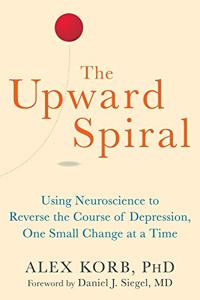
Want to learn the ideas in The Upward Spiral better than ever? Read the world’s #1 book summary of The Upward Spiral by Alex Korb here.
Read a brief 1-Page Summary or watch video summaries curated by our expert team. Note: this book guide is not affiliated with or endorsed by the publisher or author, and we always encourage you to purchase and read the full book.
Video Summaries of The Upward Spiral
We’ve scoured the Internet for the very best videos on The Upward Spiral, from high-quality videos summaries to interviews or commentary by Alex Korb.
1-Page Summary of The Upward Spiral
Overview
Have you ever been in a bad mood and it just got worse? You wanted to go back to bed, but then something came up that made you feel even more stressed. You tried your best to carry on with the day, but then things started going wrong and it was like a downward spiral into stress.
When you’re in a downward spiral, it’s hard to get out. You feel anxious and worried about what might happen, and your brain starts telling you that things are going to be bad. In this case, the author is talking about how we can escape from these spirals and start feeling better again. The key points will teach us how our brains work so we can understand why we act the way we do when in a downward spiral; they’ll also teach us what to do instead of being depressed. We’ll learn about the reptile brain (the part of our brain that controls our habits); who (in our brain) is responsible for making us feel bad; and why hugging makes us feel better after a long day at work or school.
Big Idea #1: The structure of the human brain explains how people fall into deep depressions.
If you tell a friend that you’re feeling depressed, he’ll probably ask “why?” However, to understand the causes of depression, it’s important to start with something else.
To begin, the brain has two parts: the feeling part and the thinking part. The feeling part is called the limbic system or reptile brain because it is responsible for emotions (particularly stress).
There are two parts of the brain. The old part controls emotions and is located in the back of our heads, while the new part is responsible for intelligence and it’s located right behind our foreheads.
When a person becomes depressed, the prefrontal cortex can no longer process emotions well. This leads to greater anxiety and stress.
So, a malfunctioning prefrontal cortex leads to depression. The author has a tendency toward loneliness, especially when he spends all day writing. He could make plans to meet friends after work but planning causes him stress and worsens his loneliness.
Some people fall into a downward spiral when they don’t get enough exercise, while others do so when they’re socially isolated.
Although this is true, the main reason why people experience a downward spiral is because of anxiety and worry. In the next section, you’ll learn more about those factors.
Big Idea #2: Worry and anxiety can trap you in a downward spiral.
Have you ever had a good idea, but then lost faith in it as soon as you thought about all the ways that it could go wrong? You worry and wonder how to make your plan work when so many things can go wrong.
It’s easy to see how you can get trapped in a cycle of negativity. Your brain is responsible for planning, which is also the part of your brain that worries about things.
The author once had to clean his apartment. He was planning a dinner party, but he forgot about the cleaning. So, he added that task to his list and then considered showering before the guests arrived. He worried about what people would think if they saw him in such a dirty place (his apartment).
When you’re worrying, it’s hard to think clearly. Your brain is focused on what could go wrong and not the positive things that are likely to happen. As a result, your thoughts get stuck in a loop and you can’t stop thinking about all of the bad possibilities.
Anxiety is similar to fear, but it’s caused by the potential for danger rather than an immediate threat. Both anxiety and fear involve parts of the brain that are responsible for danger, but anxiety only differs from fear in that it involves a future threat.






